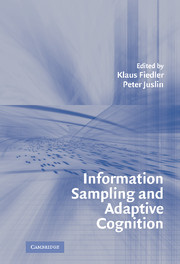Book contents
- Frontmatter
- Contents
- List of Contributors
- PART I INTRODUCTION
- PART II THE PSYCHOLOGICAL LAW OF LARGE NUMBERS
- 2 Good Sampling, Distorted Views: The Perception of Variability
- 3 Intuitive Judgments about Sample Size
- 4 The Role of Information Sampling in Risky Choice
- 5 Less Is More in Covariation Detection – Or Is It?
- PART III BIASED AND UNBIASED JUDGMENTS FROM BIASED SAMPLES
- PART IV WHAT INFORMATION CONTENTS ARE SAMPLED?
- PART V VICISSITUDES OF SAMPLING IN THE RESEARCHER'S MIND AND METHOD
- Index
- References
2 - Good Sampling, Distorted Views: The Perception of Variability
Published online by Cambridge University Press: 02 February 2010
- Frontmatter
- Contents
- List of Contributors
- PART I INTRODUCTION
- PART II THE PSYCHOLOGICAL LAW OF LARGE NUMBERS
- 2 Good Sampling, Distorted Views: The Perception of Variability
- 3 Intuitive Judgments about Sample Size
- 4 The Role of Information Sampling in Risky Choice
- 5 Less Is More in Covariation Detection – Or Is It?
- PART III BIASED AND UNBIASED JUDGMENTS FROM BIASED SAMPLES
- PART IV WHAT INFORMATION CONTENTS ARE SAMPLED?
- PART V VICISSITUDES OF SAMPLING IN THE RESEARCHER'S MIND AND METHOD
- Index
- References
Summary
Time pressure, structural limitations of the cognitive system, or paucity of available data often force people to make do with but a sample, when they try to learn of the characteristics of their environment. In such cases, sample statistics must be relied upon to infer the parameter values in the population. Because sample data provide, by definition, only a partial view of reality, the degree to which that view is a veridical reflection of reality is of great importance. It is well known that, in the quest for accurate estimates of population parameters, larger samples are to be preferred over smaller ones. This is so since the variance of the sampling distribution of any statistic is inversely related to sample size (typically to the square root of it). Still, often the size of the sample available is quite small. Consider, for example, one important limiting factor, working-memory capacity – a structural characteristic of the human cognitive system that determines the number of items that can be considered simultaneously; it is about seven items for an average adult (Miller, 1956) and could even be considerably lower than that (see Cowan, 2001, for an estimate as low as four). Nonetheless, even if the samples used by people are typically quite small in size, some solace may be obtained if one could assume their statistics to provide unbiased estimates of the population parameters in question.
- Type
- Chapter
- Information
- Information Sampling and Adaptive Cognition , pp. 33 - 52Publisher: Cambridge University PressPrint publication year: 2005



